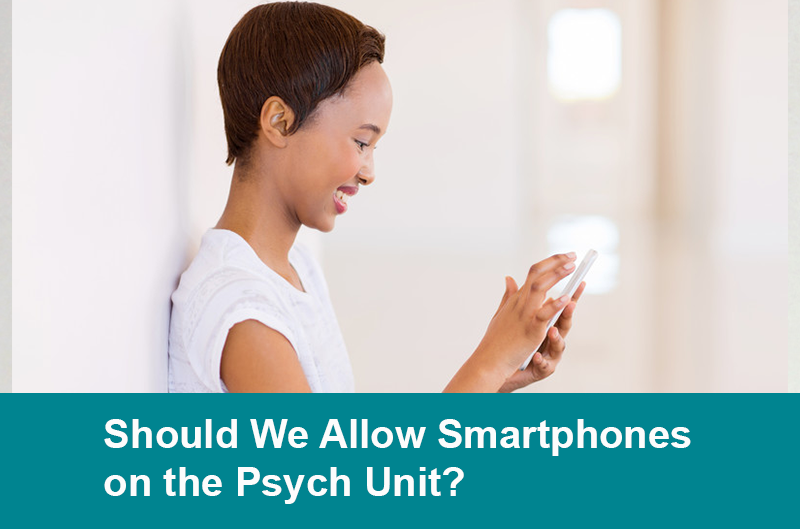Should We Allow Smartphones on the Psych Unit?
The Carlat Psychiatry Blog, Volume , Number ,
https://www.thecarlatreport.com///
It’s a bit of dogma that goes rarely challenged in inpatient psychiatry—patients can’t use smartphones. There are multiple reasons for this, ranging from privacy issues (patients might Instagram other patients), clinical issues (patients might isolate themselves and not go to groups), safety issues (they might break and use the screen glass for self harm), and liability issues (patients might sue the hospital if they lose their device). Inpatient units are usually pretty risk averse, and the various red flags have led to policies in most units forbidding use of personal electronic devices (PEDs). But this seems to be changing. At my own hospital, we are in the process of reviewing our PED policy, and I took a peek into the small literature on the topic recently. Literature review The third sticker has been placed on a phone and then removed, thus revealing a watermark that says VOID. Overall, their experience with the policy has been positive, and has improved clinical care in various ways. The “carrot” of PED privileges is an incentive leading to better behavioral control on the unit. In addition, it helps staff evaluate how patients are coping with real world stressors. Patients are dealing with relationship and job issues via their cell phones, and discuss any challenges with staff, who help them problem-solve. Treaters have also recommended various behavioral health apps to inpatients, and have been able to find out whether they benefitted patients in real time. Finally, the policy has made discharge planning more streamlined, because patients can more easily participate in arranging aftercare appointments, contacting outpatient providers, and coordinating family meetings. There have been no safety or privacy issues. The major disadvantage is that extra staff time is spent checking in and out phones. Beyond this report, I also found a good review article on the larger topic of internet access on psychiatric units (Morris, Journal of the American Academy of Psychiatry and the Law Online June 2018, 46 (2) 224-231). This article focuses on legal issues and provides an interesting history of legislation and court cases related to patient use of electronics. For example, in 1980 Congress passed and Jimmy Carter signed a “Bill of Rights” for mental health patients, which, among other things, guarantees a patient’s right to send and receive mail. This has been interpreted to include access to personal electronic devices. State Policies Other Countries Social Media Conclusions Any liberalizing of our policies needs to be done thoughtfully, however, with an eye toward protecting patient privacy and safety. In a future post, I’ll walk you through the process of creating a policy that will work for your unit. — Daniel Carlat, MD, Publisher/CEO of Carlat Publishing
I found only one article detailing a hospital’s experiences with allowing smart phones (Psychiatric Services, 2017 Sep 1;68(9):979-980). Eakley and Walton published a brief report on an inpatient unit at NYU Langone Medical Center, where they developed and implemented a new policy allowing PED use on one of their inpatient units beginning in 2013. Patient phones were charged and stored in a locked room, and patients have to sign them out. To deal with privacy issues, all phones with cameras have tamper-proof stickers placed over the lens. These stickers change appearance if they have been peeled back, so that staff can easily spot rule infractions (see image below). Not all patients are allowed PED privileges; first, they must demonstrate good behavioral control and participation in treatment programs. They report that they’ve offered PEDs to over three quarters of admitted patients since 2013.
On a state government level, it’s interesting that my own home state, Massachusetts, has one of the more enlightened state policies. The Department of Mental Health issued a policy in 2012 requiring that all DMH operated inpatient units allow patients use of PEDs, subject to various clinical criteria. You can read the policy here. And you can download a copy of their recommended consent form here.
I also checked out policies in other countries. While there’s no good clearing house of information on policies internationally, I did discover that the United Kingdom (which includes England, Northern Ireland, Scotland, and Wales) has a national policy encouraging all non-forensic psychiatric units to allow patient access to PEDs.
Another source of “information” on PED policies is the wild and wooly world of psychiatric social media. One of the best sites is the Facebook Group “Psychiatry Network.” Here 10,000 members, mostly psychiatrists, carry on active discussions of all topics psychiatric. I searched for “smartphones” and found various discussion threads. One thread, for example, was elicited by a member’s question, “Cell phone/ ipads in the inpatient unit. Yes or No? why? (cameras blocked by tape)”. There were 64 comments as of 9/21/19, the majority of them negative, with members pointing out the usual litany of potential pitfalls…however, I found no references to any published evidence base supporting the concerns.
So, should we allow smartphones on inpatient units? While we don’t have much evidence to go by, my conclusion is that the potential benefits outweigh the potential disadvantages. Smartphones have become an integral part of everyone’s life, and confiscating them from patients feels increasingly paternalistic, verging on a patient rights violation. Forcing patients to stay in a hospital is already a big intrusion, and we can mitigate this by allowing them to maintain an electronic portal to their lives. Add to this the potential treatment benefits of enlisting the patient’s help in discharge planning, testing mental health apps, and communicating with family and friends—and I believe there’s a solid case to be made for revamping our approach to this issue.


